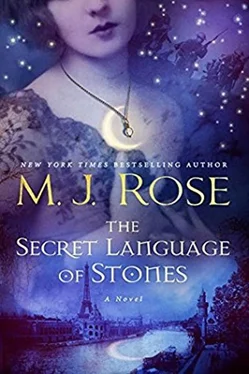In the morning, I went down to the shop and suffered through the work waiting for me, looking at the clock every quarter hour until I could finally take off my apron, put down my tools, and tell Monsieur Orloff I would be going out for a few hours on an errand during my lunch break.
With Jean Luc’s talisman against my breast, with his words in my ears, I walked to the Louvre. Because I hadn’t grown up in Paris, only visiting my great-grandmother for short periods, there were many attractions I either hadn’t seen or hadn’t seen enough of-like the great museum. And since I’d moved to Paris, the Louvre had been closed for more days than it had been open to the public. As I approached, I hoped that afternoon would be an exception.
Ahead of me, the ancient palace that had seen so many kings and queens, tragedies and intrigues, stood solid against the ravages of time. Stepping onto the plaza in front of the museum, I felt a surge of anticipation at visiting another of Jean Luc’s haunts. I had one of his unpublished columns with me. I’d copied it out so I could bring it and not miss a step of its instructions.
The Louvre was in fact open. Inside, the sheer size and grandeur of the palace overwhelmed me. To reach the first stop on Jean Luc’s tour, I climbed an ornate marble staircase. He’d written about how often he thought of the royalty who’d taken the same steps so long ago, so long dead. The concept intrigued me.
We walk in the footsteps of so many who are forgotten. What of them lingers? Do we leave some aspect of ourselves in the places we live and others we visit? If my eyes could see a plane other than this one, would the atmosphere be crowded with people who’d passed through the same halls?
I reached the first landing. Had Jean Luc stood here? Gazing up at the tall ceilings, every corner and crevice decorated in the most elaborate designs of the era, I wondered if he’d noticed the same details.
I stopped at a high arched window overlooking the courtyard. Where war-weary Parisians walked now, in search of an hour’s respite, kings and queens and nobility had once trod the same ground, weary of their own wars.
Ma chère,
The inconstancy of love is easy to speak of. We bemoan a lover’s treacheries and make light of an ex-lover’s faults. What I think of out here is the love immortalized in art. For those who hear of it in song, or on the stage, or who read of it in poetry or novels, or who see it in a painting or sculpture-it is everlasting. And offers solace to those of us who witness endless examples of instantaneous disaster here, in the muck and mud, amidst the sounds of cannons and gunfire.
Once you enter the museum, turn right and go into the Richelieu wing. Take the staircase to the first floor, and opposite the café, walk to room 4, where you can find objects from the Middle Ages. Here is our first stop on our lovers’ journey: the tapestry of a lady and her love. In the 1400s, when this lovely piece was made, the most popular story told was The Romance of the Rose. It tells the tale of a suitor’s progress through a garden of love. Here in this tapestry, he is offering her a declaration of his devotion. Look, even the animals and the flowers encircle and bind the lovers together. Step closer and look at the gift he is giving her-a heart-a symbol of his love.
Next, you will need to go to room 37 in the French collection. Stand in front of the small painting called Le Faux Pas, painted by Watteau in 1717. Of the time, Voltaire wrote that it was the age of licentiousness, and freedom was expressed not only in how people indulged in pleasures, but how they were celebrated in the arts, music, and poetry.
Stand closer and enter into the intimacy of the two lovers. A staged game of love and chance. Be the voyeur.
Have you ever watched two people make love? If you aren’t observed, it can be exhilarating. I did once and was mesmerized by the passion with which the man kissed the woman and held her. The delicate way she responded. For several minutes, I couldn’t even take a breath.
Before I could follow Jean Luc’s instructions to the next room, his voice stopped me from moving forward.
What I didn’t write was… If I were there with you now in the gallery, I would touch your neck behind your ear, with my lips, and whisper to you to just look at the painting. Not to turn to me. And while you studied the Watteau, my lips would travel down your neck until you’d need to put your hand out to steady yourself.
Jean Luc’s lips pressed on my skin. Indeed my neck was warm, growing warmer still as I studied the small painting. My cheeks flushed. A mother and teenage daughter entered the room, their presence an intrusion.
I moved on and followed Jean Luc’s instructions to the next room, where my next assignment was to study a painting entitled The Bolt , by the French master Fragonard sometime around 1777.
Positioning myself in front of the canvas, I studied the violent and sensual embrace between a man and a woman in her bedroom. Although it was a fairly small painting, Jean Luc wrote that it burst with love and desire. He said I should examine first how the strong shaft of light, almost the focal point of the work, illuminated the three major clues as to the painting’s meaning: the man pushing the bolt on the door as he grabs his lover, the rumpled messy bed, and the ripe apple on his lover’s nightstand, which symbolized the fruit of Eve, the fruit of sin.
Had I ever stood so long in front of a painting before? The longer I remained, the more fully I entered its dark sensuous world. I sensed the tension in the male lover’s legs as he pushed against his mistress. And her teasing halfhearted retreat away from him. But why was he bolting the door when, from the appearance of the room, they’d already enjoyed their amorous respite? Was he unbolting the door and she stopping him from leaving?
Suddenly, I started to see erotic symbolism in every aspect of the painting. Every inch seethed with unspent passion. The upturned chair looked now like legs up in the air. The vase and the roses suggested the woman’s genitals. And the bed itself. I sighed. It echoed the woman’s sensuality, suggesting folds of flesh. Oh, to be with Jean Luc in that bed with its deep downy pillows that looked like breasts, enclosed by the blood-red velvet curtains keeping out the world.
Alone in the room, I shocked myself by pressing my hand to my breast and holding it there. Feeling the pressure. Wanting it to be Jean Luc’s hand. Wanting him to be there in flesh and blood and pressed up against me the way the man in the painting pressed up to his lover. The sensations between my legs were so strong I leaned against the wall. How could I be aroused like this, alone, with no one near? Just from looking at a painting, from reading a dead man’s words?
There were more paintings to stop and stare at and wonder about, but I ignored them as I thought about a man who knew the Louvre so well that from a trench in Vichy he could put together a lover’s art tour and recall the room numbers of these works and their nuances.
It wasn’t just his romantic nature I thought about as I headed to the next piece; it wasn’t just his knowledge. Jean Luc’s delight delighted me, his interests interested me, his fascinations fascinated me.
And now we come to the most erotic and strange piece of all, one which might make you uncomfortable. I ask you to begin your journey from afar. Do you see the full-size marble sculpture of the sleeping figure? Slightly to the left? Wait. Don’t look at its name yet. Don’t circle it. Position yourself so you are looking at the figure’s back. Take in the curves and the languid pose. You want to touch it, don’t you? Run your fingers down the sinuous spine. Feel the satiny skin. If there are no guards in the room, do it. Dare it. Risk it. You won’t be disappointed. Finger the curve of the waist, thrill to the velvet. Almost impossible this is stone, isn’t it? You want to slip your fingers between the figure’s thighs, don’t you… to feel the warmth… so inviting, isn’t it?
Читать дальше












